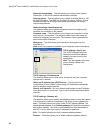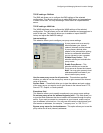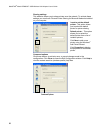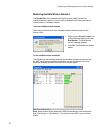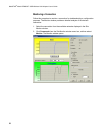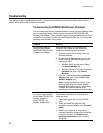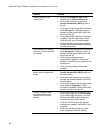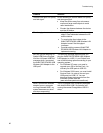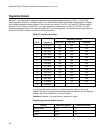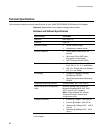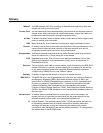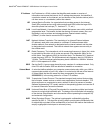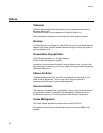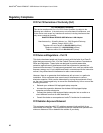
Glossary
45
Glossary
10BaseT An IEEE standard (802.3) for operating 10 Mbps Ethernet networks (LANs) with
twisted pair cabling and a wiring hub.
Access Point An inter-networking device that seamlessly connects wired and wireless networks.
Access points, when combined with a distributed system, support the creation of
multiple radio cells that enable roaming throughout a facility.
Ad Hoc A network composed solely of stations within mutual communication range of each
other (no access point connected).
BSS Basic Service Set. A set of stations controlled by a single coordination function.
Channel A medium used to pass protocol data units that can be used simultaneously in the
same volume of space by other channels of the same physical layer with an
acceptably low frame error ratio due to mutual interference.
Encapsulated An Ethernet address mode that treats the entire Ethernet packet as a whole and
places it inside an 802.11 frame along with a new header.
ESS Extended Service Set. A set of one or more interconnected Basic Service Sets
(BSSs) and integrated Local Area Networks (LANs) can be configured as an
Extended Service Set.
Ethernet The most widely used medium access method, which is defined by the IEEE 802.3
standard. Ethernet is normally a shared media LAN; for example, all the devices
on the network segment share total bandwidth. Ethernet networks operate at
10 Mbps using CSMA/CD to run over 10BaseT cables.
Gateway A network component that acts as an entrance to another network.
IEEE 802.11 The IEEE 802.xx is a set of specifications for LANs from the Institute of Electrical
and Electronic Engineers (IEEE). Most wired networks conform to 802.3 (the
specification for CSMA/CD-based Ethernet networks), or 802.5 (the specification
for token ring networks). Specification 802.11 defines the standard for wireless
LANs encompassing three incompatible (non-interoperable) technologies:
Frequency Hopping Spread Spectrum (FHSS), Direct Sequence Spread Spectrum
(DSSS), and Infrared. IEEE standards ensure interoperability between systems of
the same type.
Infrastructure A wireless network centered about an access point. In this environment, the
access point not only provides communication with the wired network but also
mediates wireless network traffic in the immediate neighborhood.
IP Internet Protocol. The standard protocol within TCP/IP that defines the basic unit
of information passed across an Internet connection by breaking down data
messages into packets, routing and transporting the packets over network
connections, then reassembling the packets at their destination. IP corresponds to
the network layer in the ISO/OSI model.



